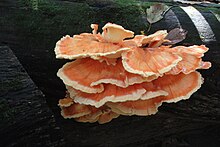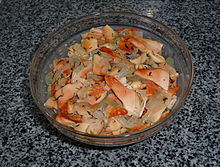Laetiporus
This article needs additional citations for verification. (July 2023) |
| Laetiporus | |
|---|---|

| |
| Laetiporus sulphureus in Belgium | |
| Scientific classification | |
| Domain: | Eukaryota |
| Kingdom: | Fungi |
| Division: | Basidiomycota |
| Class: | Agaricomycetes |
| Order: | Polyporales |
| Family: | Fomitopsidaceae |
| Genus: | Laetiporus Murr. (1904)
|
| Type species | |
| Laetiporus speciosus Battarra ex Murrill (1904)
| |
Laetiporus is a
Description

Individual "shelves" range from 5 to 25 centimetres (2 to 10 inches) across. These shelves are made up of many tiny tubular filaments (hyphae). The mushroom grows in large
Young fruiting bodies are characterized by a moist, rubbery, sulphur-yellow to orange body sometimes with bright orange tips. Older brackets become pale and brittle almost chalk-like, mildly pungent, and are often dotted with beetle or slug/woodlouse holes.
The name "chicken of the woods" is not to be confused with another edible polypore, Maitake (Grifola frondosa) known as "hen of the woods/rams head” or with Lyophyllum decastes, known as the "fried chicken mushroom".
Taxonomy
Phylogeny
- Conifericola clade: contains species that live on angiosperms.
- Cincinnatus clade: contains L. cincinnatus.
- Sulphureus clade I: contains white-pored L. sulphureus isolates.
- Sulphureus clade II: contains yellow-pored L. sulphureus isolates.
- Gilbertsonii clade: contains L. gilbertsonii and unidentified Caribbean isolates.
In addition, phylogenetic clades have been identified from Japan, Hawaii, South America, Europe, and South Africa.[2]
Species
- Laetiporus ailaoshanensis[3] B.K.Cui & J.Song (2014)
- Laetiporus baudonii (Pat.) Ryvarden (1991)
- Laetiporus caribensis Banik & D.L.Lindner (2012)
- Laetiporus cincinnatus(Morgan) Burds., Banik & T.J.Volk (1998)
- Laetiporus conifericola Burds. & Banik (2001)
- Laetiporus cremeiporus Y.Ota & T.Hatt. (2010)
- Laetiporus discolor (Klotzsch) Corner (1984)
- Laetiporus flos-musae Overeem (1927)
- Laetiporus gilbertsonii Burds. (2001)
- Laetiporus huroniensis Burds. & Banik (2001)
- Laetiporus miniatus (P.Karst.) Overeem (1925)
- Laetiporus montanus Černý ex Tomšovský & Jankovský (2009)
- Laetiporus persicinus (Berk. & M.A.Curtis) Gilb. (1981)
- Laetiporus portentosus (Berk.) Rajchenb. (1995)
- Laetiporus squalidus R.M.Pires, Motato-Vásq. & Gugliotta (2016)[4]
- Laetiporus sulphureus (Bull.) Murrill (1920)
- Laetiporus versisporus (Lloyd) Imazeki (1943)
- Laetiporus zonatus[3] B.K.Cui & J.Song (2014)
Etymology
The name Laetiporus means "with bright pores".[5]
Distribution and habitat
The sulphur shelf mushroom is most commonly found on wounds of trees, mostly
It sometimes comes back year after year when the weather suits its sporulation preferences. From late spring to early autumn, the sulphur shelf thrives, making it a boon to mushroom hunters and a bane to those concerned about the health of their trees. This fungus causes a brown cubical rot and embrittlement which in later stages ends in the collapse of the host tree, as it can no longer flex and bend in the wind.[citation needed]

Chicken of the woods is found growing on or at the base of dead or dying hardwood trees; most commonly on oak but also cherry or beech. It can also be found on dead conifer stumps. Chicken of the woods has been known to fruit on living trees as well. It typically grows from spring to early fall.
Uses
The mushroom can be prepared in most ways that one can prepare

In some cases eating the mushroom "causes mild reactions ... for example, "swollen lips" or in rare cases "nausea, vomiting, dizziness and disorientation" to those who are sensitive.
L. sulphureus has a potent ability to inhibit staph bacteria (Staphylococcus aureus), as well as moderate ability to inhibit the growth of Bacillus subtilis.[7]
See also
References
- S2CID 25173644.
- S2CID 9711234.
- ^ S2CID 22823127.
- .
- ISBN 978-0-472-85610-7.
- ^ Michael W. Beug. "Poisonous and hallucinogenic mushrooms". Archived from the original on September 22, 2017. Retrieved Feb 21, 2013.
- S2CID 23654559.
External links
 Media related to Laetiporus at Wikimedia Commons
Media related to Laetiporus at Wikimedia Commons- Mushroom-Collecting.com - Laetiporus
